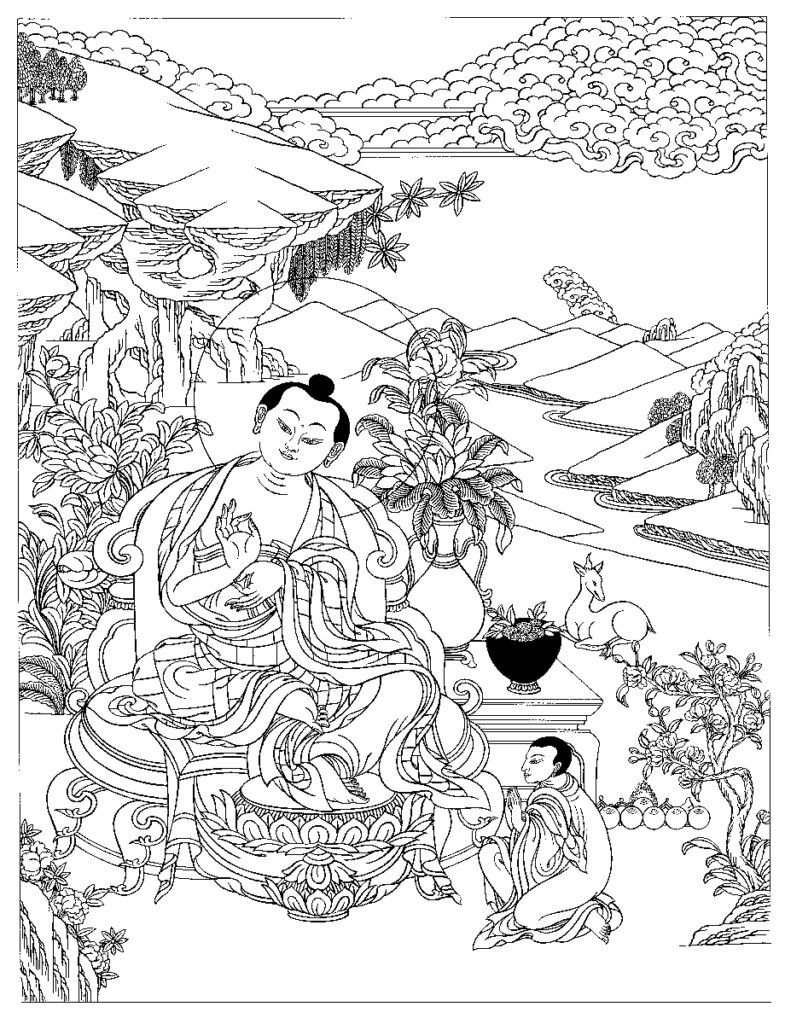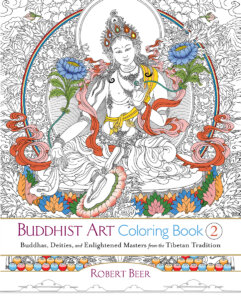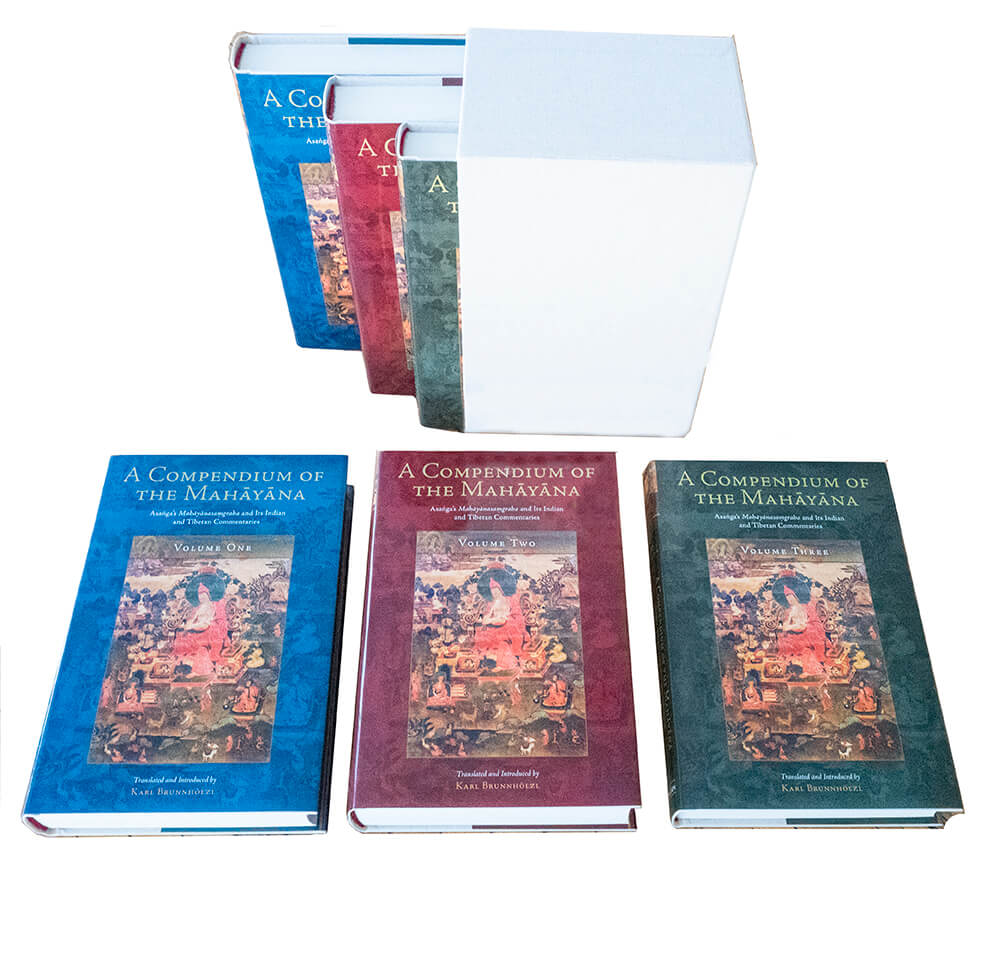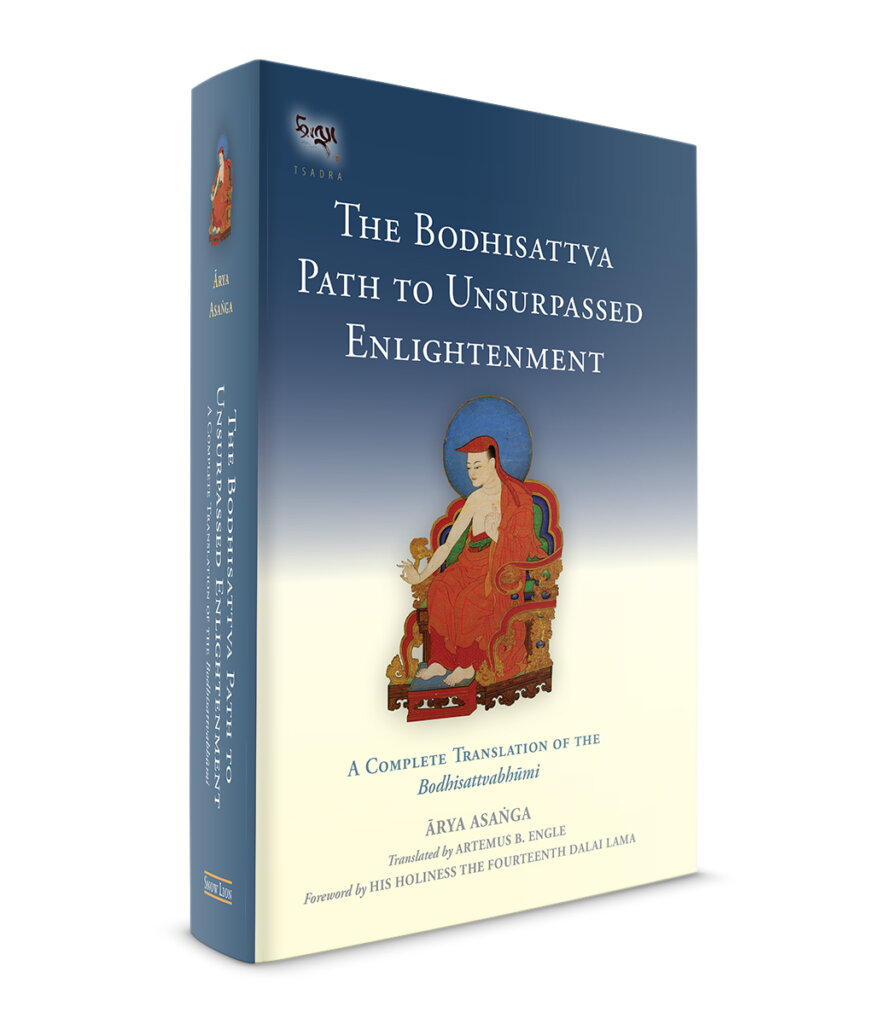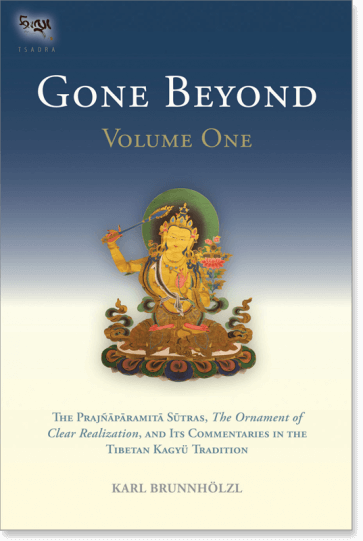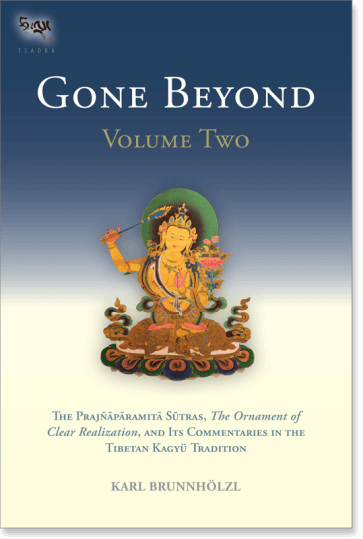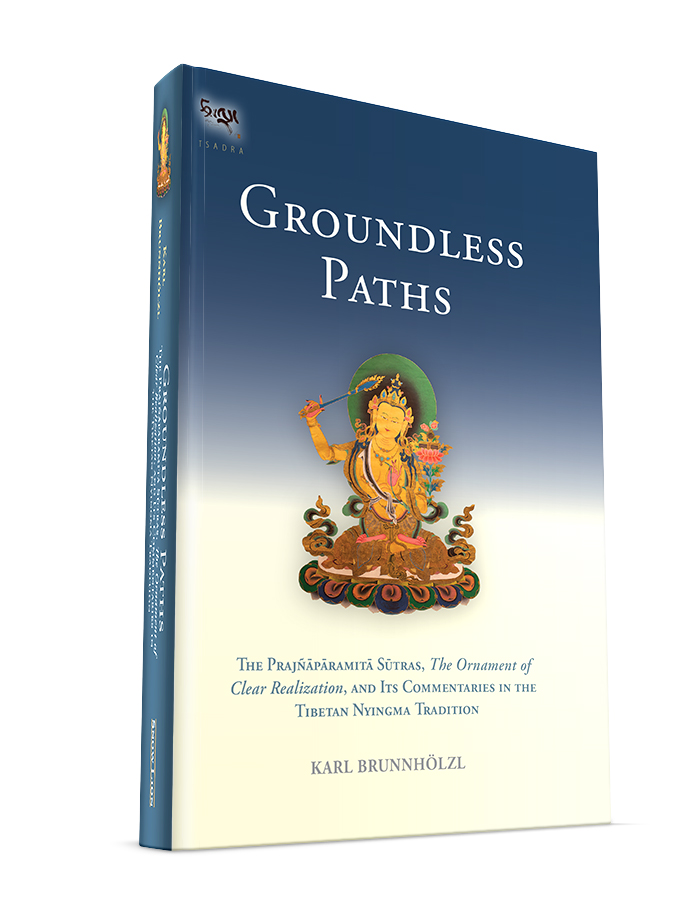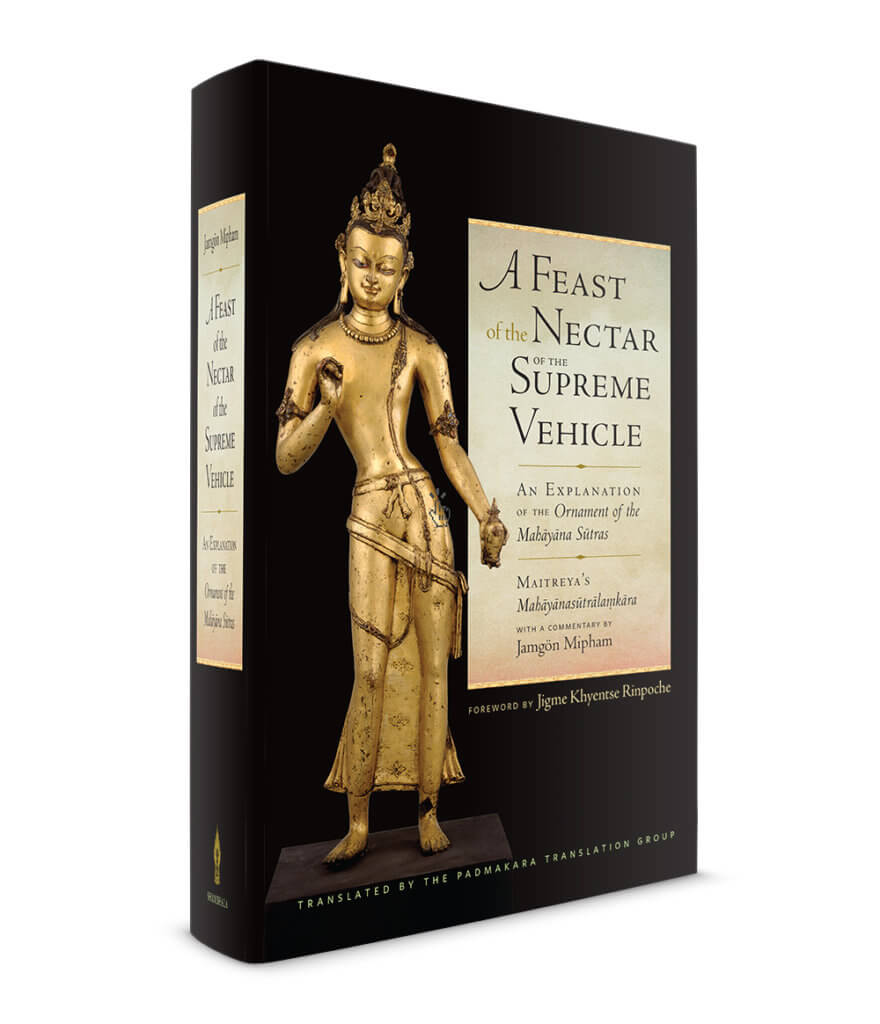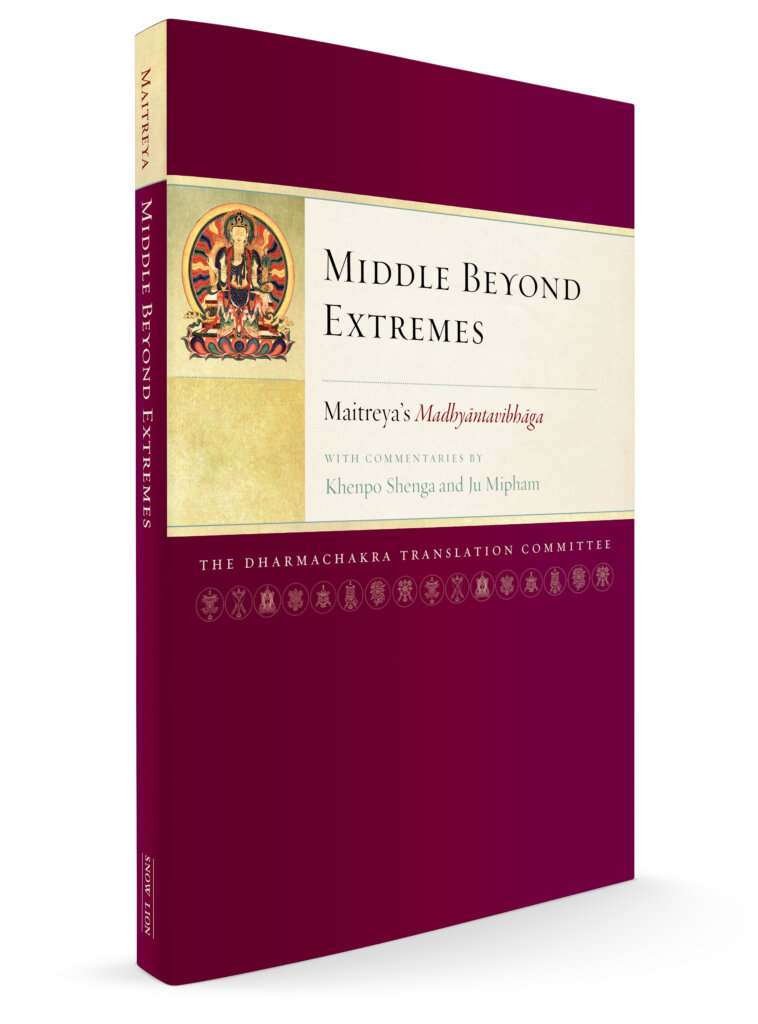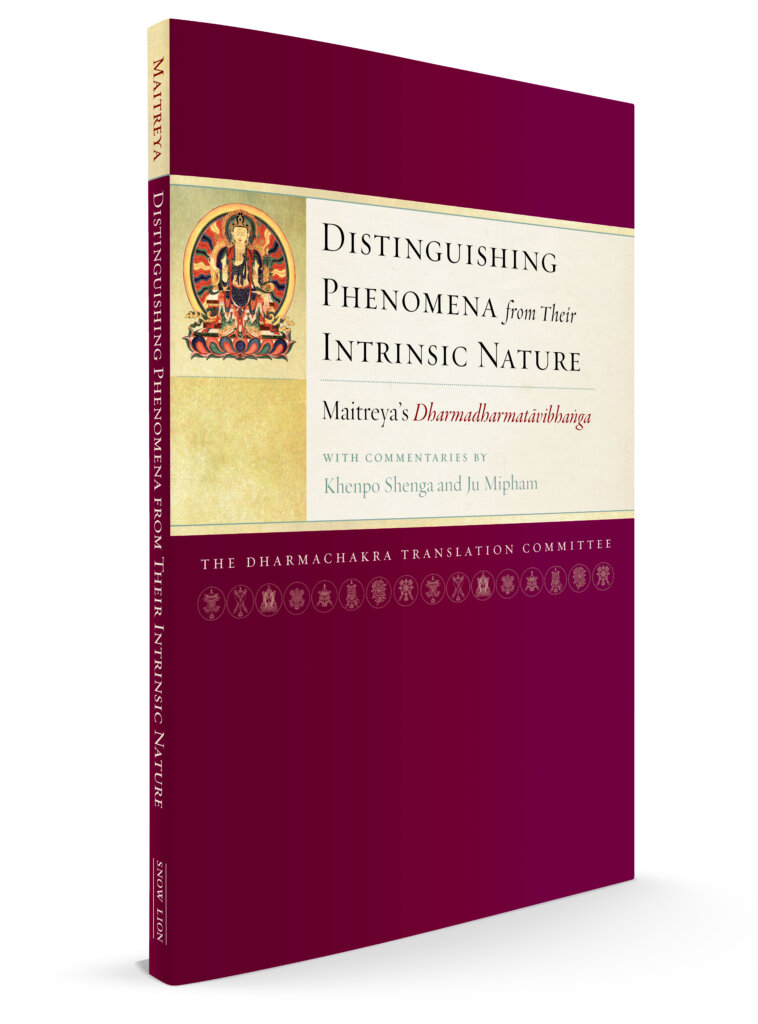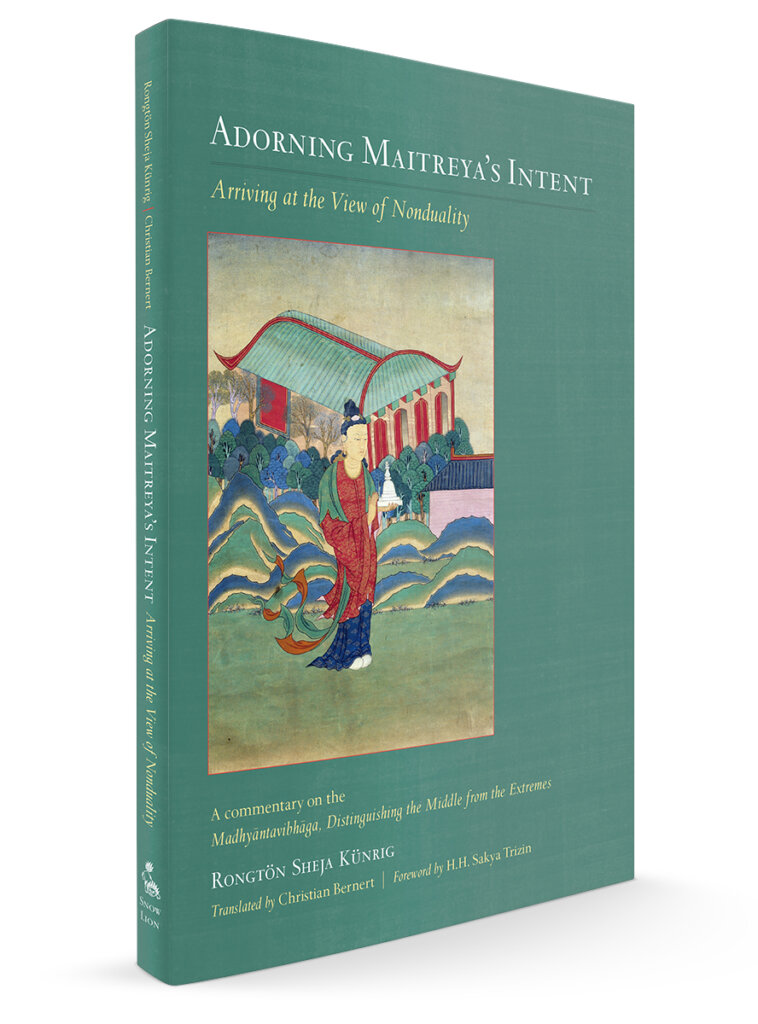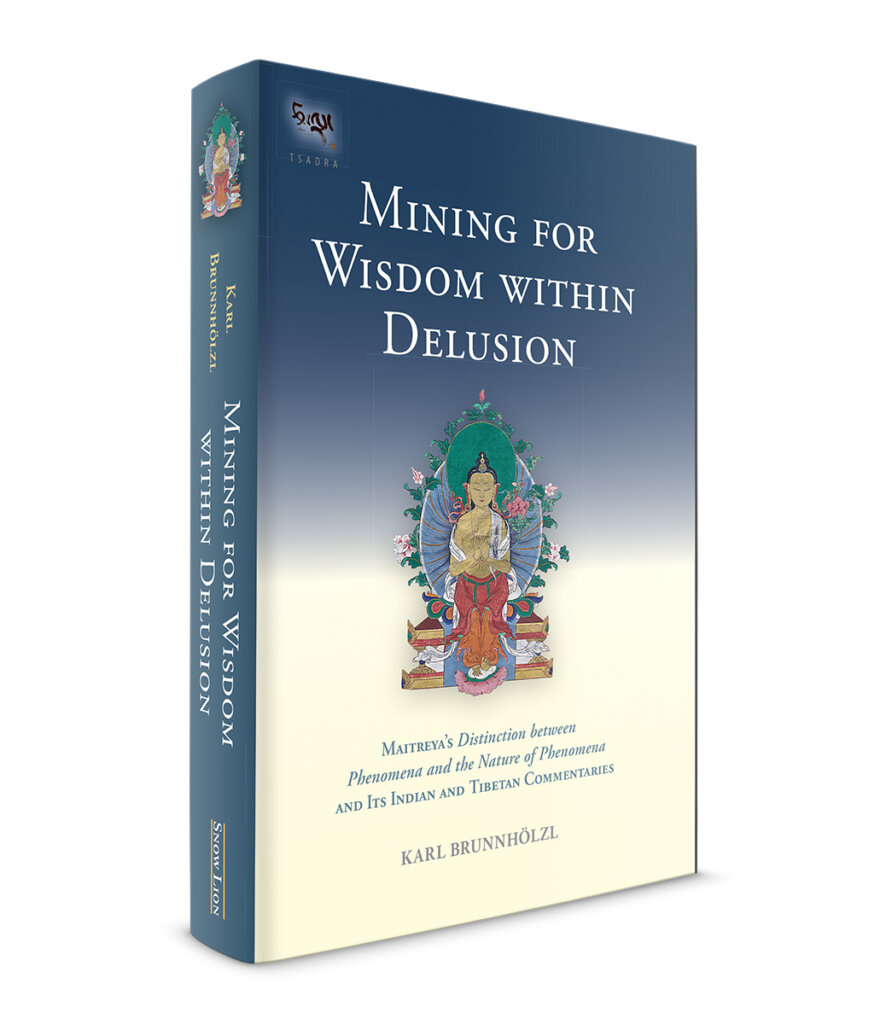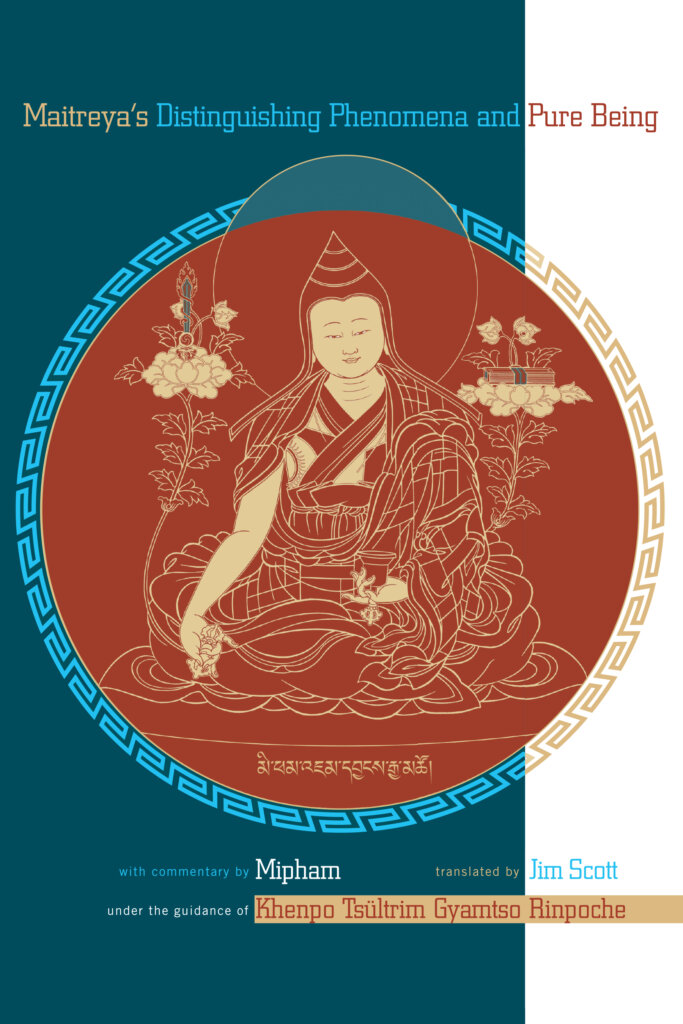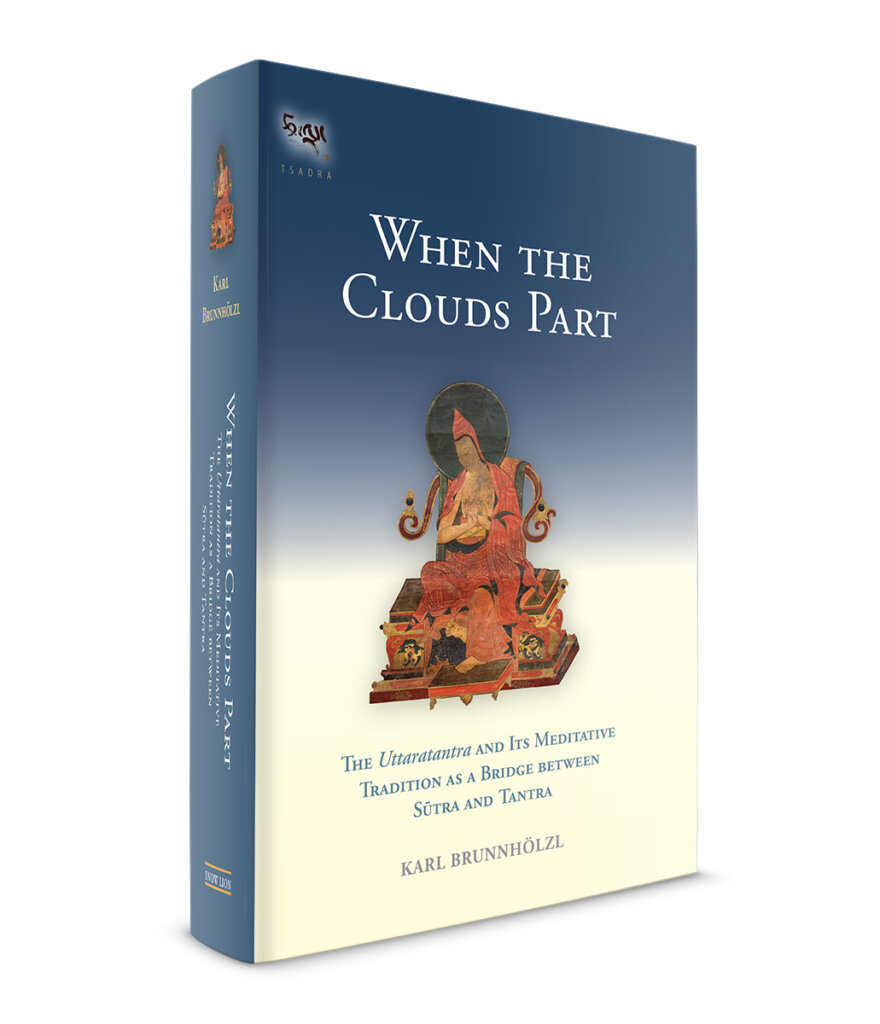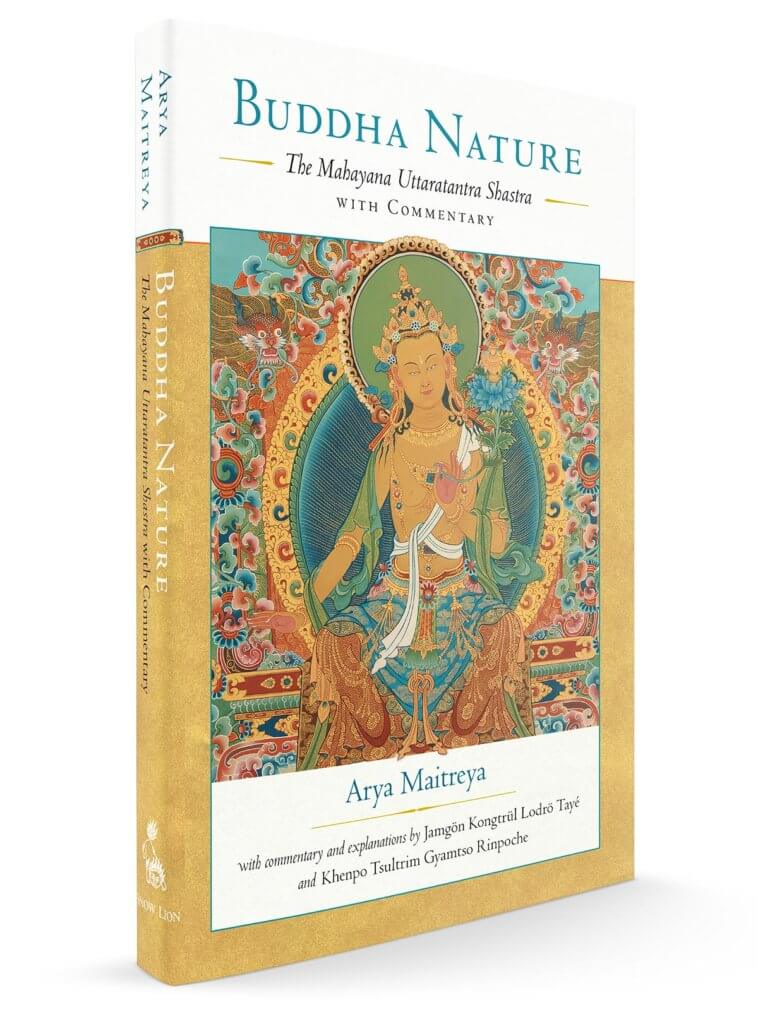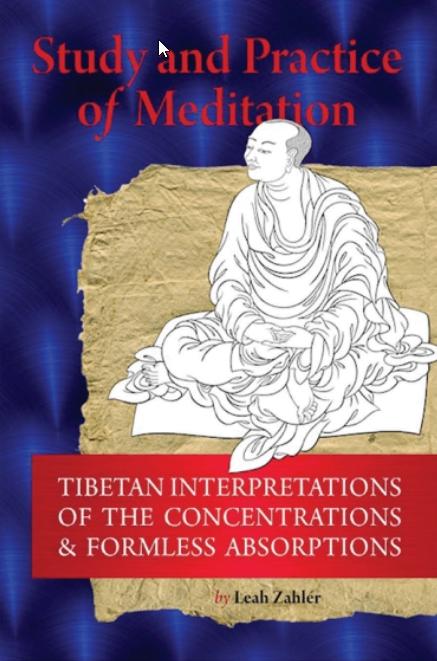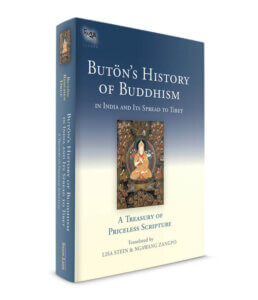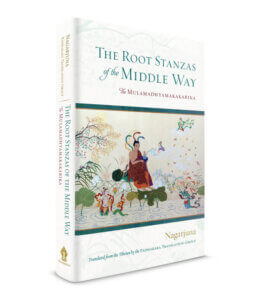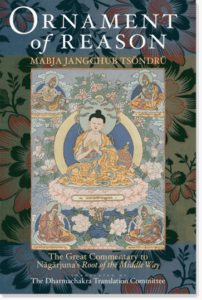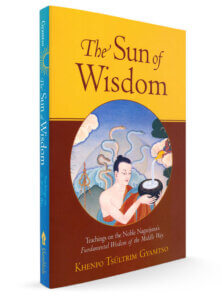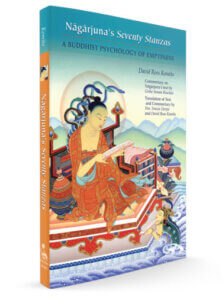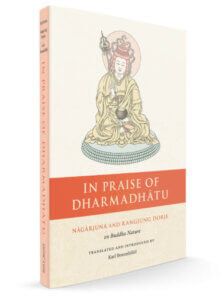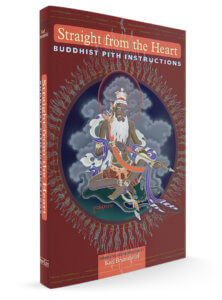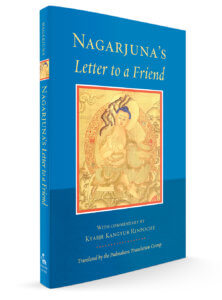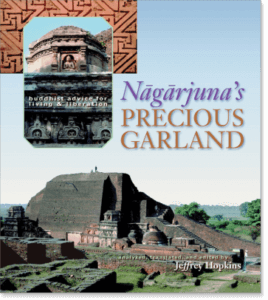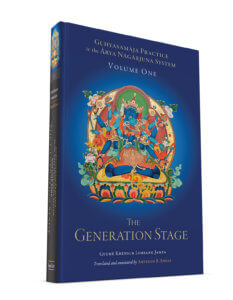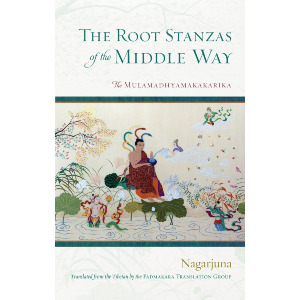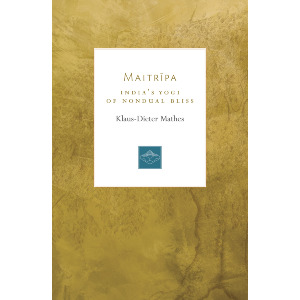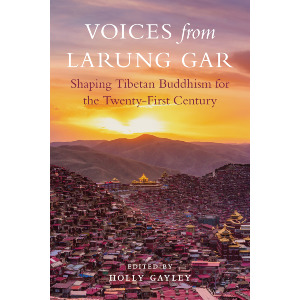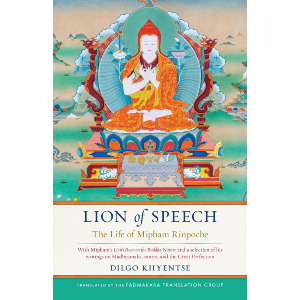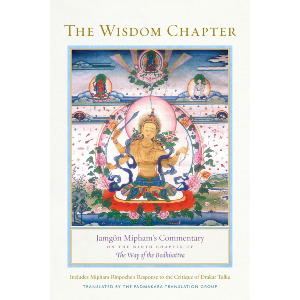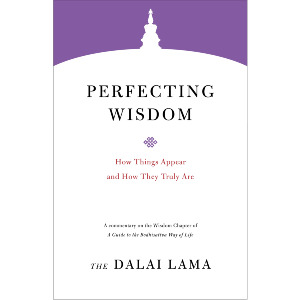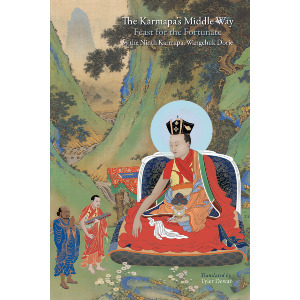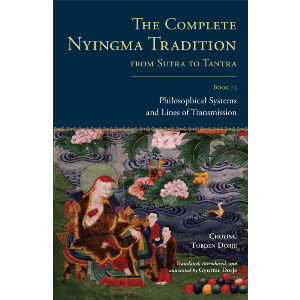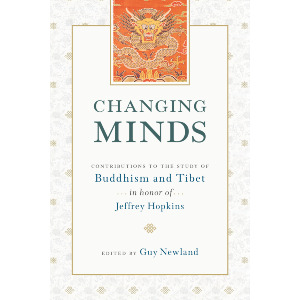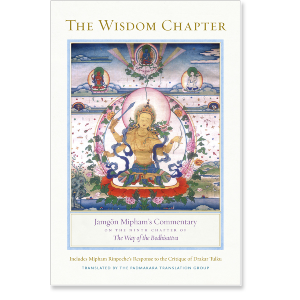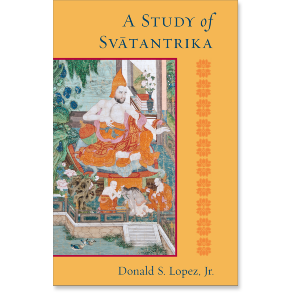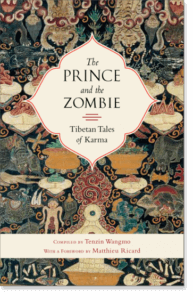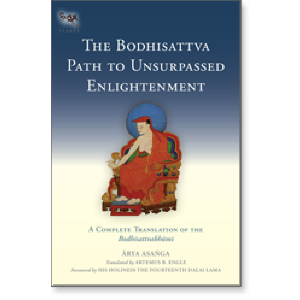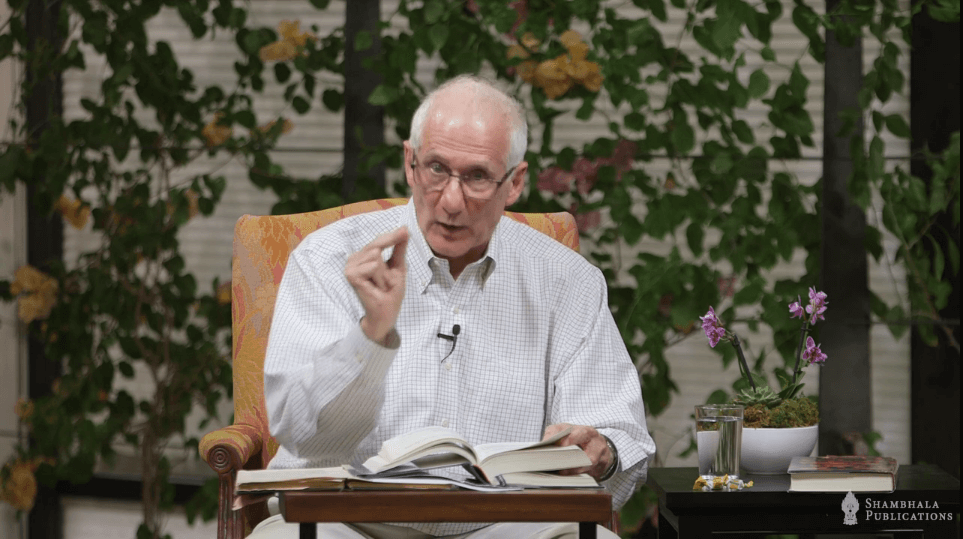

Artemus B. Engle
Artemus B. Engle studied Buddhism with the late Sera Mey Khensur Lobsang Tharchin Rinpoche for more than thirty years. Over much of the past decade he has continued his studies as a student of Gyumé Khensur Lobsang Jampa Rinpoche. In 1983 he earned a doctorate in Buddhist Studies from the University of Wisconsin and is currently a fellow with the Tsadra Foundation.
Artemus B. Engle
-
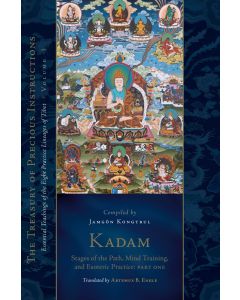 Kadam: Stages of the Path, Mind Training, and Esoteric Practice, Part One$54.95- Hardcover
Kadam: Stages of the Path, Mind Training, and Esoteric Practice, Part One$54.95- HardcoverBy Jamgon Kongtrul Lodro Taye
Translated by Artemus B. Engle -
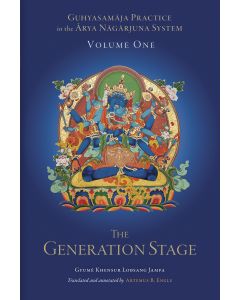 Guhyasamaja Practice in the Arya Nagarjuna System, Volume One$49.95- Hardcover
Guhyasamaja Practice in the Arya Nagarjuna System, Volume One$49.95- HardcoverTranslated by Artemus B. Engle
By Gyumé Khensur Lobsang Jampa -
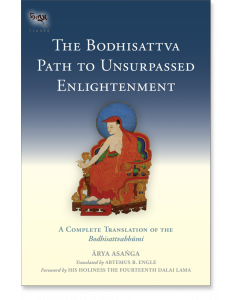 The Bodhisattva Path to Unsurpassed Enlightenment$59.95- Hardcover
The Bodhisattva Path to Unsurpassed Enlightenment$59.95- HardcoverBy Asanga
Translated by Artemus B. Engle
Foreword by H.H. the Fourteenth Dalai Lama -
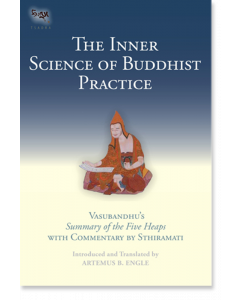 The Inner Science of Buddhist Practice$34.95- Hardcover
The Inner Science of Buddhist Practice$34.95- HardcoverTranslated by Artemus B. Engle
By Vasubandhu
By Sthiramati
- Treasury of Precious Instructions 1 item
- Buddhist Academic 2item
- Buddhist Biography/Memoir 1 item
- Buddhist History 3item
- Buddhist Overviews 1 item
- Buddhist Philosophy 3item
- Dependent Origination 2item
- Four Noble Truths 2item
- Abhidharma 1 item
- Bodhisattva Path 1 item
- Gelug Tradition 1 item
- Kadam Tradition 1 item
- Tantra 1 item
- Yogacara 2item
GUIDES
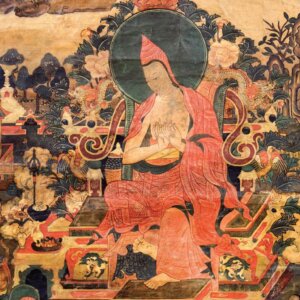
Asanga and Yogacara: A Guide for Readers

Asanga
Asanga, from The Buddhist Art Coloring Book
Asanga, along with his brother Vasabandu, is an inestimably important figure in Mahayana Buddhism, associated with some of the most important works on ethical and moral dimensions of progress on the path, as well as the Yogacara philosophical school. He is particularly revered in Tibet and East Asia.
Asanga is best known for his two "Summary Treatises" and the teachings he received from Maitreya, the Five Maitreya texts.
The following is from Indestructible Truth: The Living Spirituality of Tibetan Buddhism:
Asanga, considered the founder of the Yogachara school, was born into a Buddhist family in the region of Gandhara in northwestern India.3 As a child, he was drawn strongly to meditation but was also schooled in the major divisions of learning then current in India, including writing, debate, mathematics, medicine, and the fine arts. Asanga was a brilliant student and excelled at whatever he tried. At an early age, he took Buddhist ordination within a Hinayana sect, the Mahishasaka, known for the great importance it attached to the practice of meditation.
Asanga trained under several teachers, mastering the Hinayana scriptures and studying Mahayana sutras. When he encountered the Prajnaparamita sutras, however, he found that while he could read their words, he did not really understand their inner meaning or the awakening they described. Asanga felt compelled by these teachings and recognized that the only way he could gain the transcendent wisdom that he longed for would be to enter into a meditation retreat. Having received instruction from his guru, he now went into strict retreat on Mount Kukkutapada. He spent his time meditating and supplicating his personal deity, the future buddha, Maitreya, for guidance, inspiration, and teaching.
Essential Texts by Asanga
Three Volume Slipcase | Ebook
$150.00 - Hardcover
A Compendium of the Mahayana: Asanga’s Mahayanasamgraha and Its Indian and Tibetan Commentaries
By Karl Brunnholzl
Asanga's The Compendium of the Mahayana, or Mahāyānasaṃgraha, is one of the greatest works expounding the Yogacara teachings of Mahayana. It is also an incrediblefeat of translation, done by master translator and scholar Karl Brunnholzl.
The Mahāyānasaṃgraha, published here with its Indian and Tibetan commentaries in three volumes, presents virtually everything anybody might want to know about the Yogācāra School of Mahāyāna Buddhism. It discusses in detail the nature and operation of the eight kinds of consciousness, the often-misunderstood notion of “mind only” (cittamātra), dependent origination, the cultivation of the path and its fruition in terms of the four wisdoms, and the three bodies (kāyas) of a buddha.
Volume 1 presents the translation of the Mahāyānasaṃgraha along with a commentary by Vasubandhu. The introduction gives an overview of the text and its Indian and Tibetan commentaries, and explains in detail two crucial elements of the Yogācāra view: the ālaya-consciousness and the afflicted mind (klistamanas).
Volume 2 presents translations of the commentary by Asvabhāva and an anonymous Indian commentary on the first chapter of the text. These translations are supplemented in the endnotes by excerpts from Tibetan commentaries and related passages in other Indian and Chinese Yogācāra works.
Volume 3 includes appendices with excerpts from other Indian and Chinese Yogācāra texts and supplementary materials on major Yogācāra topics in the Mahāyānasaṃgraha.
Hardcover | Ebook
$59.95 - Hardcover
The Bodhisattva Path to Unsurpassed Enlightenment: A Complete Translation of the Bodhisattvabhumi
By Asanga, translated by Artemus Engle
Ārya Asanga’s Bodhisattvabhūmi, or The Stage of a Bodhisattva, is the Mahāyāna tradition’s most comprehensive manual on the practice and training of bodhisattvas—by the author’s own account, a compilation of the full range of instructions contained in the entire collection of Mahāyāna sutras. A classic work of the Yogācāra school, it has been cherished in Tibet by all the historical Buddhist lineages as a primary source of instruction on bodhisattva ethics, vows, and practices, as well as for its summary of the ultimate goal of the bodhisattva path—supreme enlightenment.
Despite the text’s seminal importance in the Tibetan traditions, it long remained unavailable in English except in fragments. Engle’s translation, made from the Sanskrit original with reference to the Tibetan translation and commentaries, will enable English readers to understand more fully and clearly what it means to be a bodhisattva and practitioner of the Mahāyāna tradition.
A Deep Dive on the Bodhisattvabhumi
Once you have a copy of The Bodhisattva Path to Unsurpassed Enlightenment, a great complement to reading the book is to watch translator and scholar Artemus Engle discuss the work in detail, offering great context. Watch the preview here for a taste, and then jump right into the two talks, free to all.
Overview and Trailer
Part I, 1.5 Hours
Part II, 2 Hours
The Five Maitreya Texts
See also our two interviews on these texts with Karl Brunnholzl and Thomas Doctor of the Dharmachakra Translation Committee.
In Peaceful Heart, Dzigar Kongtrul Rinpoche recounts the story of how Asanga met Maitreya and received the teachings that come down to us as The Five Maitreya texts:
Asanga isolated himself in strict retreat, devoting all his time to practices related to Maitreya. His hope was for Maitreya to appear before him and give him instructions that would lead him to enlightenment. But after six years of diligent practice with no results, Asanga got frustrated and left. On his way home, he met a man who was rubbing a large iron bar with a soft piece of cloth. When Asanga asked what he was doing, the man said he was making a needle. Amazed at the effort people go through to accomplish futile aims, Asanga realized he needed to be more persistent on his path to enlightenment. So he returned to his retreat, determined never to give up. But three years later, when Maitreya still hadn’t appeared, not even in a dream, Asanga again left. This time he met a man who was stroking a massive boulder with a feather dipped in water. The man told him that he wanted to wear away the boulder because it was blocking the sunlight from his house. This gave Asanga renewed determination to keep persevering with his practice. But still Maitreya didn’t come.
Another uneventful and discouraging three years passed. Finally, Asanga left again and began to wander around, feeling hopeless and lost. He saw a crippled dog dragging herself along the road. Her rotting body was infested with maggots that were eating her flesh. Full of pain and aggression, the dog barked viciously at Asanga when he came closer. The sight broke Asanga’s heart. He thought about how to remove the maggots. If he used his hands, the maggots would probably be crushed, so the only way was to use his tongue. Disgusted by the rotting flesh, Asanga closed his eyes and stretched out to lick the maggots out of the dog. But as far as he stretched, he still didn’t feel the maggots. Finally, he felt his tongue touch the ground. He opened his eyes. Instead of the dog, Maitreya stood before him.
"How little compassion you have!" Asanga burst out. "I practiced for twelve years, and you didn’t even appear in my dreams!” Maitreya said, “Since the very first day of your retreat, I’ve been right there with you, but you didn’t have the openness to see me. Your twelve years of practice made your obscurations thinner. Today, your pure compassion for this dog finally made you open enough to see me in person. If you don’t believe me, put me on your shoulder and walk around.” Asanga put Maitreya on his shoulder and walked around at a fair, asking people what they saw on his shoulder. No one saw anything. They just thought he was crazy. Finally, an old woman, who also had developed enough openness to have higher perceptions, asked, “Why are you carrying a rotten dog on your shoulder?"
From then on, Maitreya imparted the teachings which we now know as The Five Maitreya Texts.
The Ornament of Clear Realization: The Abhisamayālaṃkāra
The Abhisamayalamkara summarizes all the topics in the vast body of the Prajnaparamita Sutras. Resembling a zip-file, it comes to life only through its Indian and Tibetan commentaries. Together, these texts not only discuss the "hidden meaning" of the Prajnaparamita Sutras—the paths and bhumis of sravakas, pratyekabuddhas, and bodhisattvas—but also serve as contemplative manuals for the explicit topic of these sutras—emptiness—and how it is to be understood on the progressive levels of realization of bodhisattvas. Thus these texts describe what happens in the mind of a bodhisattva who meditates on emptiness, making it a living experience from the beginner's stage up through buddhahood.
The Ornament of Clear Realization
Karl Brunnholzl discussing the two Gone Beyond volumes on the Kagyu tradition and the Ornament of Clear Realization and Groundless Paths which is the Nyingma take on the same work
Hardcover | Ebook
$54.95 - Hardcover
Gone Beyond (Volume 1)
The Prajnaparamita Sutras, The Ornament of Clear Realization, and Its Commentaries in the Tibetan Kagyu Tradition
By Asanga, Maitreya, the Fifth Shamar Rinpoche, and Karl Brunnholzl
Gone Beyond contains the first in-depth study of the Abhisamayalamkara (the text studied most extensively in higher Tibetan Buddhist education) and its commentaries in the Kagyu School. This study (in two volumes) includes translations of Maitreya's famous text and its commentary by the Fifth Shamarpa Goncho Yenla (the first translation ever of a complete commentary on the Abhisamayalamkara into English), which are supplemented by extensive excerpts from the commentaries by the Third, Seventh, and Eighth Karmapas and others. Thus it closes a long-standing gap in the modern scholarship on the Prajnaparamita Sutras and the literature on paths and bhumis in mahayana Buddhism.
The first volume presents an English translation of the first three chapters of the Abhisamayalamkara and its commentary by the Fifth Shamarpa.
Hardcover | Ebook
$44.95 - Hardcover
Gone Beyond (Volume 2)
The Prajnaparamita Sutras, The Ornament of Clear Realization, and Its Commentaries in the Tibetan Kagyu Tradition
By Asanga, Maitreya, the Fifth Shamar Rinpoche, and Karl Brunnholzl
The second volume presents an English translation of the final five chapters and their commentary by the Fifth Shamarpa.
Hardcover | Ebook
$54.95 - Hardcover
Groundless Paths: The Prajnaparamita Sutras, The Ornament of Clear Realization, and Its Commentaries in the Tibetan Nyingma Tradition
By Asanga, Maitreya, Patrul Rinpoche, Mipham Rinpoche, and Karl Brunnholzl
This study consists mainly of translations of Maitreya's famous text and two commentaries on it by Patrul Rinpoche. These are supplemented by three short texts on the paths and bhumis by the same author, as well as extensive excerpts from commentaries by six other Nyingma masters, including Mipham Rinpoche. Thus this book helps close a long-standing gap in the modern scholarship on the prajñaparamita sutras and the literature on paths and bhumis in mahayana Buddhism.
The Ornament of Mahayana Sutras: The Māhayānasūtrālaṃkāra
Padmakara's Stephen Gethin on the Mahāyānasūtrālaṃkāra
A discussion of the Feast of the Nectar of the Supreme Vehicle and the importance of Mipham Rinpoche's commentary.
Hardcover | Ebook
$54.95 - Hardcover
A Feast of the Nectar of the Supreme Vehicle: An Explanation of the Ornament of the Mahayana Sutras
By Asanga, Mipham Rinpoche. Translated and introduced by the Padmakara Translations Group
A monumental work and Indian Buddhist classic, the Ornament of the Mahāyāna Sūtras (Mahāyānasūtrālamkāra) is a precious resource for students wishing to study in-depth the philosophy and path of Mahāyāna Buddhism. This full translation and commentary outlines the importance of Mahāyāna, the centrality of bodhicitta or the mind of awakening, the path of becoming a bodhisattva, and how one can save beings from suffering through skillful means.
This definitive composition of Mahāyāna teachings was imparted in the fourth century by Maitreya to the famous adept Asanga, one of the most prolific writers of Buddhist treatises in history. Asanga’s work, which is among the famous Five Treatises of Maitreya, has been studied, commented upon, and taught by Buddhists throughout Asia ever since it was composed.
In the early twentieth century, one of Tibet’s greatest scholars and saints, Jamgön Mipham, wrote A Feast of the Nectar of the Supreme Vehicle, which is a detailed explanation of every verse. This commentary has since been used as the primary blueprint for Tibetan Buddhists to illuminate the depth and brilliance of Maitreya’s pith teachings. The Padmakara Translation Group has provided yet another accessible and eloquent translation, ensuring that English-speaking students of Mahāyāna will be able to study this foundational Buddhist text for generations to come.
Distinguishing the Middle from Extremes: The Madhyāntavibhāga
This text explains the vast paths of all three yanas, emphasizing the view of Yogācāra (including the Yogācāra Middle Way) and the distinctive features of the mahāyāna.
Paperback | Ebook
$22.95 - Paperback
Middle Beyond Extremes: Maitreya's Madhyantavibhaga with Commentaries by Khenpo Shenga and Ju Mipham
By Asanga, Khenpo Shenga, Mipham Rinpoche. Translated and introduced by the Padmakara Translations Group
This text employs the principle of the three natures to explain the way things seem to be as well as the way they actually are. It is presented here alongside commentaries by two outstanding masters of Tibet’s nonsectarian Rimé movement, Khenpo Shenga and Ju Mipham.
Distinguishing Phenomena from Their Intrinsic Nature : The Dharmadharmatāvibhāga
This text discusses the difference between samsaric confusion and the liberating power of nonconceptual wisdom-the heart essence of all profound sutras.
Paperback | Ebook
$18.95 - Paperback
Distinguishing Phenomena from Their Intrinsic Nature: Maitreya's Dharmadharmatavibhanga with Commentaries by Khenpo Shenga and Ju Mipham
By Asanga, Maitreya, Khenpo Shenga, Mipham Rinpoche. Translated and introduced by the Dharmachakra Translation Committee
Outlining the difference between appearance and reality, this work shows that the path to awakening involves leaving behind the inaccurate and limiting beliefs we have about ourselves and the world around us and opening ourselves to the limitless potential of our true nature.
By divesting the mind of confusion, the treatise explains, we see things as they actually are. This insight allows for the natural unfolding of compassion and wisdom. This volume includes commentaries by Khenpo Shenga and Ju Mipham, whose discussions illuminate the subtleties of the root text and provide valuable insight into the nature of reality and the process of awakening.
Paperback | Ebook
$24.95 - Paperback
Adorning Maitreya’s Intent: Arriving at the View of Nonduality
By Asanga, Maitreya, Rongtonpa, introduced and translated by Christian Bernert
Here, the Tibetan master Rongtön unpacks this manual and its practices for us in a way that is at once accessible and profound, with actual practical meditative applications. The work explains the vast paths of the three vehicles of Buddhism, emphasizing the view of Yogācāra, and demonstrates the inseparability of experience and emptiness. It offers a detailed presentation of the three natures of reality, an accurate understanding of which provides the antidotes to confusion and suffering. The translator’s introduction presents a clear overview of all the concepts explored in the text, making it easy for the reader to bridge its ideas to actual practice.
Hardcover | Ebook
$39.95 - Hardcover
Mining for Wisdom within Delusion: Maitreya's Distinction between Phenomena and the Nature of Phenomena and Its Indian and Tibetan Commentaries
By Asanga, Maitreya, Vasabandhu, Gö Lotsāwa, The Third Karmapa Rangjung Dorje, . Translated and introduced by Karl Brunnholzl.
Maitreya’s Distinction between Phenomena and the Nature of Phenomena distinguishes the illusory phenomenal world of saṃsāra produced by the confused dualistic mind from the ultimate reality that is mind’s true nature. The transition from the one to the other is the process of “mining for wisdom within delusion.” Maitreya’s text calls this “the fundamental change,” which refers to the vanishing of delusive appearances through practicing the path, thus revealing the underlying changeless nature of these appearances. In this context, the main part of the text consists of the most detailed explanation of nonconceptual wisdom—the primary driving force of the path as well as its ultimate result—in Buddhist literature.
The introduction of the book discusses these two topics (fundamental change and nonconceptual wisdom) at length and shows how they are treated in a number of other Buddhist scriptures. The three translated commentaries, by Vasubandhu, the Third Karmapa, Rangjung Dorje, and Gö Lotsāwa, as well as excerpts from all other available commentaries on Maitreya’s text, put it in the larger context of the Indian Yogācāra School and further clarify its main themes. They also show how this text is not a mere scholarly document, but an essential foundation for practicing both the sūtrayāna and the vajrayāna and thus making what it describes a living experience. The book also discusses the remaining four of the five works of Maitreya, their transmission from India to Tibet, and various views about them in the Tibetan tradition.
Paperback | Ebook
$24.95 - Paperback
Maitreya's Distinguishing Phenomena and Pure Being
By Asanga, Maitreya, and Mipham Rinpoche. Translated by Jim Scott under the guidance of Khenpo Tsultrim Gyamtso.
Maitreya’s Distinction between Phenomena and the Nature of Phenomena distinguishes the illusory phenomenal world of saṃsāra produced by the confused dualistic mind from the ultimate reality that is mind’s true nature. The transition from the one to the other is the process of “mining for wisdom within delusion.” Maitreya’s text calls this “the fundamental change,” which refers to the vanishing of delusive appearances through practicing the path, thus revealing the underlying changeless nature of these appearances. In this context, the main part of the text consists of the most detailed explanation of nonconceptual wisdom—the primary driving force of the path as well as its ultimate result—in Buddhist literature.
The introduction of the book discusses these two topics (fundamental change and nonconceptual wisdom) at length and shows how they are treated in a number of other Buddhist scriptures. The three translated commentaries, by Vasubandhu, the Third Karmapa, Rangjung Dorje, and Gö Lotsāwa, as well as excerpts from all other available commentaries on Maitreya’s text, put it in the larger context of the Indian Yogācāra School and further clarify its main themes. They also show how this text is not a mere scholarly document, but an essential foundation for practicing both the sūtrayāna and the vajrayāna and thus making what it describes a living experience. The book also discusses the remaining four of the five works of Maitreya, their transmission from India to Tibet, and various views about them in the Tibetan tradition.
The Sublime Continuum: The Uttaratantra Śāstra
Also known as the Ratnagotravibhāga Mahāyānottaratantraśāstra, this is a general commentary on buddha nature and represents a bridge between sutra and tantra.
Hardcover | Ebook
$49.95 - Hardcover
When the Clouds Part: The Uttaratantra and Its Meditative Tradition as a Bridge between Sutra and Tantra
By Asanga, Karl Brunnholzl, Mipham Rinpoche, Pema Karpo, Mönlam Tsültrim, Eighth Karmapa, Jamgon Kongtrul and more.
This book discusses a wide range of topics connected with the notion of buddha nature as presented in Indo-Tibetan Buddhism and includes an overview of the sūtra sources of the tathāgatagarbha teachings and the different ways of explaining the meaning of this term. It includes new translations of the Maitreya treatise Mahāyānottaratantra (Ratnagotravibhāga), the primary Indian text on the subject, its Indian commentaries, and two (hitherto untranslated) commentaries from the Tibetan Kagyü tradition. Most important, the translator’s introduction investigates in detail the meditative tradition of using the Mahāyānottaratantra as a basis for Mahāmudrā instructions and the Shentong approach. This is supplemented by translations of a number of short Tibetan meditation manuals from the Kadampa, Kagyü, and Jonang schools that use the Mahāyānottaratantra as a work to contemplate and realize one’s own buddha nature.
Paperback | Ebook
$34.95 - Paperback
Buddha Nature: The Mahayana Uttaratantra Shastra with Commentary
By Maitreya, Asanga, Jamgon Kongtrul, Khenpo Tsultrim Gyamtso, translated by Rosemarie Fuchs
All sentient beings, without exception, have buddha nature—the inherent purity and perfection of the mind, untouched by changing mental states. Thus there is neither any reason for conceit nor self-contempt. This is obscured by veils that are removable and do not touch the inherent purity and perfection of the nature of the mind. The Mahayana Uttaratantra Shastra, one of the “Five Treatises” said to have been dictated to Asanga by the Bodhisattva Maitreya, presents the Buddha’s definitive teachings on how we should understand this ground of enlightenment and clarifies the nature and qualities of buddhahood. This seminal text details with great clarity the view that forms the basis for Vajrayana, and especially Mahamudra, practice.
Paperback | Ebook
$39.95 - Paperback
Study and Practice of Meditation
Tibetan Interpretations of the Concentrations and Formless Absorptions
By Leah Zahler
Study and Practice of Meditation gives a vivid and detailed account of the meditative practices necessary to develop a calm, alert mind that is capable of penetrating the depths of reality. The Buddhist meditative states known as the concentrations and formless absorptions are best known in the West from Theravada scriptures and from Vasubandhu’s Treasury of Manifest Knowledge. Asanga's Summary of Manifest Knowledge (abhidharmasamuccaya, mngon pa kun btus) and his Grounds of Hearers (śrāvakabhūmi, nyan sa)also feature heavily.
In this book the reader is exposed to Tibetan Buddhist views on the mental states attained through meditation as described by three Geluk lamas. The book discusses the ways in which certain meditative states act as bases of the spiritual path as well as the nature of meditative calm and the prerequisites for cultivating and attaining it. In addition to reviewing and translating Tibetan sources, the author considers their major Indian antecedents and draws comparisons with Theravadin presentations.
Additional Resources on Asanga
On Lotsawa House Asanga appears in many translations, generally as a figure in a prayer. 

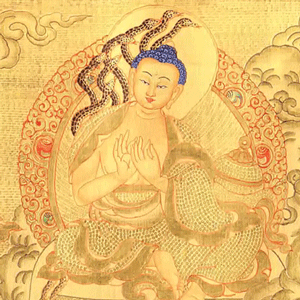

Nagarjuna
Nagarjuna
circa 150 – c. 250 CE
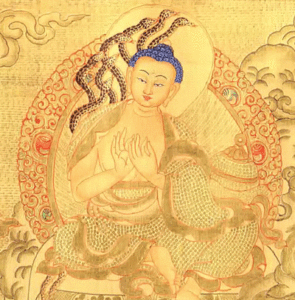
Of Nagarjuna’s life, we know almost nothing. He is said to have been born into a Brahmin family in the south of India around the beginning of the second century CE. He became a monk and a teacher of high renown and exerted a profound and pervasive influence on the evolution of the Buddhist tradition in India and beyond. Much of his life seems to have been spent at Sriparvata in the southern province of Andhra Pradesh, at a monastery built for him by king Gotamiputra, for whom he composed the Suhrllekha, his celebrated Letter to a Friend.
Nagarjuna is intimately associated with the Prajnaparamita sutras, the teachings on the Perfection of Wisdom, the earliest-known examples of which seem to have appeared in written form around the first century BCE, thus coinciding with the emergence of Mahayana, the Buddhism of the Great Vehicle.
It is recorded in the Pali Canon that the Buddha foretold the disappearance of some of his most profound teachings. They would be misunderstood and neglected, and would fall into oblivion. “In this way,” he said, “those discourses spoken by the Tathāgata that are deep, deep in meaning, supramundane, dealing with emptiness, will disappear.” There is no knowing whether on that occasion he was referring to the Perfection of Wisdom, but it is certain that the earliest exponents of the Mahayana believed that, with the Prajnaparamita scriptures, they were recovering a profound and long-lost doctrine. Nagarjuna seems to have been deeply implicated in this rediscovery. Questions of historicity aside, the story that he brought back seven volumes of the Prajnaparamita sutras from the subterranean realm of the nagas, where they had been preserved, conveys a clear message. In the eyes of Nagarjuna’s contemporaries and of later generations, the appearance of the Prajnaparamita sutras marked a new beginning in the history of Buddhism, and yet the teachings they contained were not innovations. And in their interpretation and propagation, Nagarjuna played a crucial role.
-Excerpted from the "Translator's Preface," The Root Stanzas of the Middle Way translated by Padmakara Translation Group
Jump to sections on this page:
Nagarjuna's Life | Madhayamaka & Reasoning | Praises
Advice | Tantra | Recent Works on Madhyamaka | Other Works and Resources

Nagarjuna's Life
A more comprehensive biography of Nagarjuna can be found in Butön's History of Buddhism in India and Its Spread to Tibet. A fourteenth-century Tibetan classic that serves as an excellent introduction to basic Buddhism as practiced throughout India and Tibet and describes the process of entering the Buddhist path through study and reflection.
What follows is a brief composite biography from a variety of sources including Butön Rinchen Drup's biography of Nagarjuna.
Overcoming his fated death
Nagarjuna was born to a Brahmin family in Vidarbha in present-day Maharashtra, India. Predicted to have a short life, he avoided an early demise by taking ordination at Nalanda monastery with Rahulabhadra, identified in some accounts as being the mahasiddha Saraha and in others as being the abbot of Nalanda; regardless, he is best known for his works in praise of Prajñaparamita. With an ordination name of Sriman, Nagarjuna undertook thorough studies of Buddhist teachings and became successful in defeating both Buddhists and non-Buddhists in debate.
Prajñaparamita sutras
Several nagas heard Sriman's teaching and subsequently invited him down into their realm, from which he later brought back special naga clay that was used in the construction of many temples and stupas. He also brought back, most famously, important Prajñaparamita sutras. Thenceforth he became known as Nagarjuna.
Butön describes the meaning of the name beautifully:
Naga signifies birth from the basic space of phenomena, abiding in neither the extreme of eternalism or nihilism, mastery over the vault of precious scriptures, and being endowed with the view that burns and illuminates. Arjuna signifies one who has procured worldly power. Thus, he is named Arjuna because he governs the kingdom of the doctrine and subdues the hosts of faulty enemies. Taken together, these two parts form the name "Nagarjuna."
Nagarjuna's activities were vast; his better-known accomplishments include the building of two structures in Bodhgaya- the stone fence around the Vajra Seat beneath the Bodhi tree and the stupa that sits atop the Mahabodhi Temple - as well as the wall around the great Dhanyakataka Stupa at Amaravati in present-day Andhra Pradesh.
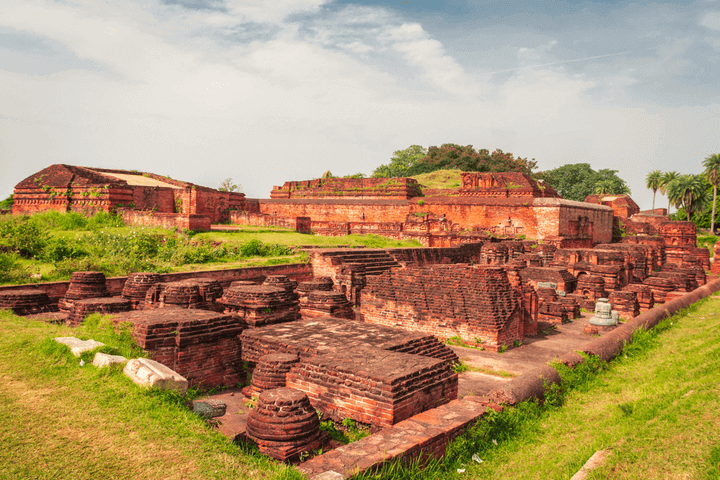
Karma at work
Nagarjuna passed away when he offered his head to a greedy prince who thought he could ensure his own long life by killing Nagarjuna. No blade would cut Nagarjuna, but he told the prince that in a past life he had killed an insect with a blade of kusha grass, so his head could be cut off with a blade of that grass which the prince then did.
It is believed that Nagarjuna's head and body were separated but do not decay and over time move closer together. Once they rejoin, his activity will continue.
Nagarjuna's Texts
The Tibetan Tengyur ascribes about one hundred eighty texts on both the sutras and tantras to him. There is a lot of scholarly debate about what Nagarjuna did and did not actually write, which is outside the scope of this article. Instead, we will focus on the major works widely attributed to him that are available in English.
His treatises are divided in various ways. Mabja Jangchub Tsondru divides them into three groups:
- Those belonging to the Causal Vehicle of Characteristics
- Those belonging to the Resultant Vehicle of Secret Mantra
- Those that show the two above to be identical in meaning
A bit arbitrarily, we will follow another traditional division which groups the treatises as follows: works on reasoning, praises, and advice. This schema ignores the large body of work on tantra and medicine, but most of what is available in English is included in these three groupings.
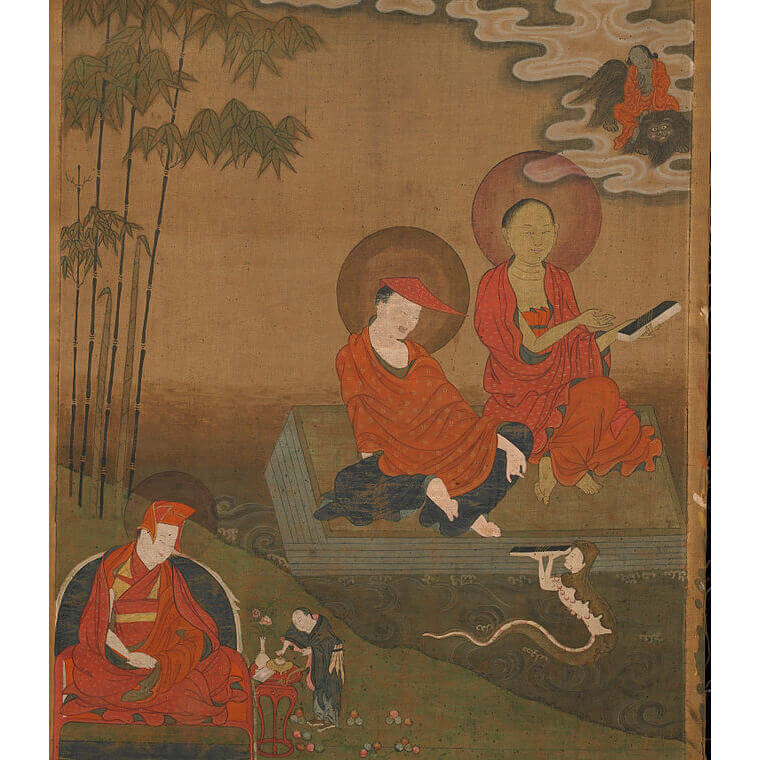
Nagarjuna on Madhyamaka & Reasoning
To him who taught that things arise dependently,
Not ceasing, not arising,
Not annihilated nor yet permanent,
Not coming, not departing,
Not different, not the same:
The stilling of all thought, and perfect peace:
To him, the best of teachers, perfect Buddha, I bow down.
The above verse is from Nagarjuna's famed Root Stanzas of the Middle Way—by far his most widely studied text.
The Root Stanzas of the Middle Way
This volume presents a new English translation of the founding text of the Madhyamaka (Middle Way) school of Mahayana Buddhism, Nagarjuna’s Root Stanzas of the Middle Way (Mulamadhyamakakarika) and includes the Tibetan version of the text. The Root Stanzas holds an honored place in all branches of Tibetan Buddhism, as well as in the Buddhist traditions found in China, Japan, and Korea, because of the way it develops the seminal view of emptiness (shunyata), which is crucial to understanding Mahayana Buddhism and central to its practice. It is prized for its pithy and pointed arguments that show that things lack intrinsic being and thus are “empty” (shunya). They abide in the Middle Way, free from the extremes of permanence and annihilation.
This translation was done following the commentary by Mipham Rinpoche, thus appealing to a living tradition that stretches back unbroken to the Tibetan translators and through their Sanskrit mentors to Nagarjuna himself.
The present work contains Nagarjuna's verses on the Middle Way accompanied by Mabja Jangchub Tsöndrü's famed commentary, the Ornament of Reason. Active in the twelfth century, Mabja was among the first Tibetans to rely on the works of the Indian master Candrakirti, and his account of the Middle Way exercised a deep and lasting influence on the development of Madhyamaka philosophy in all four schools of Buddhism in Tibet. Sharp, concise, and yet comprehensive, the Ornament of Reason has been cherished by generations of scholar-practitioners. The late Khunu Lama Tenzin Gyaltsen Rinpoche, a renowned authority on the subject, often referred to this commentary as "the best there is." A visual outline of the commentary has been added that clearly shows the structure of each chapter and makes the arguments easier to follow.
Hardcover | eBook
$27.99 - eBook
Paperback | eBook
$24.95 - Paperback
The Sun of Wisdom: Teachings on the Noble Nagarjuna's Fundamental Wisdom of the Middle Way
by Khenpo Tsultrim Gyamtso
An excellent contemporary commentary on the Mulamadhyamakakarika is Khenpo Tsultrim Gyamtso's The Sun of Wisdom. Focusing on the most important root verses, it is a very accessible entryway into this fundamental but challenging text.
As Khen Rinpoche says,
All the verses in this book are excellent supports for developing your precise knowledge of genuine reality through study, reflection, and meditation. You should recite them as much as possible, memorize them, and reflect on them until doubt-free certainty in their meaning arises within. Then you should recall their meaning again and again, to keep your understanding fresh and stable. Whenever you have time, use them as the support for the practices of analytical and resting meditation. If you do all of this, it is certain that the sun of wisdom will dawn within you, to the immeasurable benefit of yourselves and others.
Paperback | eBook
$27.95 - Paperback
by David Ross Komito and Geshe Sonam Rinchen
Nagarjuna's Shunyatasaptati, or Seventy Stanzas on Emptiness (there are actually seventy-three), is an expansion of the seventh section of the Root Verses, "Analysis of Characteristics of the Conditioned," that addresses some questions people had about the presentation of conditioned phenomena and whether that conflicted with sutra teachings. As is often the case, the answer lies in the difference between the conventional point of view of beings and how things actually are.
Additional Texts on Reasoning by Other Publishers
Of the remaining texts in this category,
- Nagarjuna's Yuktisastika, or Sixty Verses on Reasoning, has been translated by Joseph Loizzo as Nagarjuna's Reason Sixty and is available from Columbia University Press.
- The Vigrahavyavartani, or Refutation of Objections, was translated most recently by Jan Westerhoff and published as The Dispeller of Disputes by Oxford University Press.
- And lastly, Nagarjuna's Vaidalyaprakarana is included in Nagarjuniana by Christian Lindtner, published by Motilal Banarsidass.
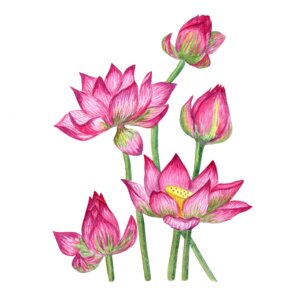
Nagarjuna's Praises
The Tibetan Tengyur identifies eighteen works of praise by Nagarjuna, and this praise is generally directed at Buddha Shakyamuni.
Paperback | eBook
$29.95 - Paperback
Translated and introduced by Karl Brunnholzl
While most of Nagarjuna's praises are directed to Buddha Shakyamuni, the main work of Nagarjuna's praises we have in English is the Dharmadhatustava, translated as In Praise of Dharmadhatu, and this work directs praise instead at the ultimate nature of mind. Karl Brunnhölzl's translation, which includes an in-depth introduction to Nagarjuna and his works in general and this one specifically, also contains a commentary by the Third Karmapa Rangjung Dorje.
The text shows how our buddha nature is obscured by stains but also how the stains can be removed by following the path of the Mahayana and can be fully revealed as buddhahood. Rangjung Dorje's commentary is also of particular interest because even though he is known for his shentong views, this commentary shows how his actual understanding is far more subtle than scholars have sometimes supposed and is in fact an elegant synthesis of the two great streams of the Mahayana, Madhyamaka, and Yogacara.
Paperback | eBook
$49.95 - Paperback
Translated and introduced by Karl Brunnholzl
Three other praises of Nagarjuna's are included in the collection Straight from the Heart, also translated and introduced by Karl Brunnhölzl</a>. Interestingly, in these praises, Nagarjuna often refers to buddhahood in positive terms, in contrast to much of his other work, which deconstructs any possibility of phenomena truly existing. As Brunnhölzl points out, despite there being nothing to pinpoint in the dharmadhatu as the nature of the mind, it can still be experienced directly and personally in a non-referential way. In other words, enlightenment is not some empty, dark nothingness, but wide-awake awareness of mind completely free from reference points.
Nagarjuna's Advice
There are seven texts included in the advice category. The two most famous are the Suhrllekha, or Letter to a Friend, and the Ratnavali, or Nagarjuna's Precious Garland: Buddhist Advice for Living and Liberation.
Paperback | eBook
$24.95 - Paperback
Nagarjuna's Letter to a Friend: With Commentary by Kangyur Rinpoche
Translated by the Padmakara Translation Group
Letter to a Friend is a set of verses of advice to a king whose identity is uncertain but who was most likely one of a number of kings in present-day Andhra Pradesh. There are several translations of Letter to a Friend, the most recent one being by the Padmakara Translation Group, which includes a commentary by Kyabje Kangyur Rinpoche.
The 123 verses are some of the most frequently quoted lines in all of Tibetan Buddhism and are taught often to this day. The text covers the entire Mahayana path, fusing daily conduct with the framework of stages that lead beings to fully enlightened buddhahood. It makes the entire path totally accessible to laypeople, demonstrating how to completely immerse oneself in the spiritual life while still living in society.
Paperback | eBook
$27.95 - Paperback
Translated by Jeffrey Hopkins
Precious Garland has been categorized by some as belonging among Nagarjuna's works on reasoning, but more traditionally it is part of the advice collection.
In the Precious Garland, he offers intimate counsel on how to conduct one's life and how to construct social policies that reflect Buddhist ideals. The advice for personal happiness is concerned first with improving one's condition over the course of lifetimes, and then with release from all kinds of suffering, culminating in Buddhahood. Nagarjuna describes the cause and effect sequences for the development of happiness within ordinary life, as well as the practices of wisdom, realizing emptiness, and compassion that lead to enlightenment. He describes a Buddha's qualities and offers encouraging advice on the effectiveness of practices that reveal the vast attributes of Buddhahood. In his advice on social and governmental policy, Nagarjuna emphasizes education and compassionate care for all living beings. He also objects to the death penalty. Calling for the appointment of government figures who are not seeking profit or fame, he advises that a selfish motivation will lead to misfortune. The book includes a detailed analysis of attachment to sensual objects as a preparation for realization of the profound truth that, when realized, makes attachment impossible.
Nagarjuna on Tantra
The one work we have is not actually by Nagarjuna but the basis for it is Nagarjuna's Piṇḍīkramaḥ and the Sūtramelāpakam.
Guhyasamaja Practice in the Arya Nagarjuna System, Volume One: The Generation Stage
by Gyumé Khensur Lobsang Jampa, translated by Artemus Engle
The Guhyasamāja Tantra is one of the Unexcelled Yoga Tantras of Vajrayana Buddhism. In the initial, generation-stage practice, one engages in a prescribed sequence of visualizations of oneself as an enlightened being in a purified environment in order to prepare one’s mind and body to engage in the second stage: the completion stage. The latter works directly with the subtle energies of one’s mind and body and transforms them into the enlightened mind and body of a buddha. In this book, Gyumé Khensur Lobsang Jampa, a former abbot of Gyumé Tantric College, provides complete instructions on how to practice the generation stage of Guhyasamāja, explaining the visualizations, offerings, and mantras involved, what they symbolize, and the purpose they serve. These instructions, which are usually imparted only orally from master to student after the student has been initiated into the Guhyasamāja mandala, are now being published in English for the first time and are supplemented by extracts from key written commentaries in the footnotes to support practitioners who have received the required transmissions from a holder of this lineage. The complete self-generation ritual is included in the second part of the book, with the Tibetan on facing pages, which can be used by those who read Tibetan and want to recite the ritual in Tibetan.
Hardcover | eBook
$49.95 - Hardcover
Subsequent Commentaries by Great Indian and Tibetan Masters
There are of course so many commentaries and commentaries on commentaries for Nagarjuna's work, by masters including the following:
...and many more great teachers up to the present. Several of these are included in subsequent Great Masters Series articles.
Recent works on Madhyamaka
Other Works and Resources
Paperback | eBook
$19.95 - Paperback
The Prince and the Zombie: Tibetan Tales of Karma
By Tenzin Wangmo, foreword by Matthieu Ricard
One last book should be mentioned here, as it's a bit of a leap from the traditional texts by and literature about Nagarjuna. The Prince and the Zombie: Tibetan Tales of Karma by Tenzin Wangmo is a book based on Tibetan oral folktale traditions.
In this book,was published in the spring of 2015, a young prince encounters Nagarjuna, who guides him and gives him the task of bringing a zombie-that's really the best translation available-back from one of the great charnel grounds of India. It is a story full of magic and excitement and could serve as a brief vacation for the mind in between studying verses on emptiness!
Discover Related Reader's Guides on the Great Masters
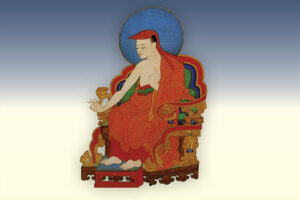
From the Introduction to Asanga's Bodhisattvabhumi
From Artemus Engle's introduction to his translation of Asang'a Bodhisattvabhumi
A Manual for the Entire Bodhisattva Collection of Discourses
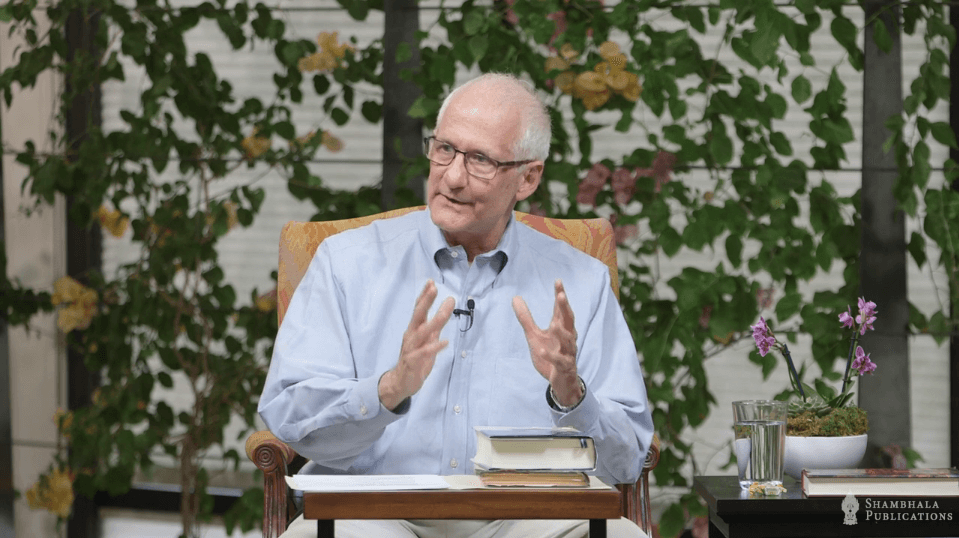
Regarding this topic, the extensive discourses fully present the bodhisattva path—which is to say, the seven stages and the four types of conduct—and fully present the qualities of a buddha—which is to say, the one hundred and forty unique buddha qualities that range from the four forms of complete purity up to the knowledge of all aspects and of what is most excellent—all of which are described in The Stage of a Bodhisattva. Because these teachings are great in number, highly exalted in their subject matter, and practiced for three vast periods of time each consisting of a countless number of kalpas, they are called the "extensive discourses."
A few lines later the same work describes the category of teachings known as "instructions":
Regarding this topic, the division of the Buddha’s speech called "instructions" contains the matrika compilations that have been extracted from the sutra discourses. Regarding these, all of the extracts from the sutra discourses that constitute the definitive meaning of the Buddha’s teaching are called matrika compilations. Those sutra teachings in which the defining characteristics of entities are presented, as well as the instructions in which the defining characteristics of entities are presented unerringly by those listeners who are abiding in the realization that perceives the nature of things, are what are contained in the matrika compilations and they are also what are contained in the Abhidharma collection.
Just as an alphabet is the starting point for learning treatises on language and secular crafts, the explanations of the defining characteristics of entities should be understood as the starting point for learning the Buddha’s overall teaching. Just as the written word cannot become evident without an alphabet, likewise the meanings of the twelve categories of the sutra teachings will not become evident if the meanings of the defining characteristics of entities have not been established and they will become evident when the meanings of the defining characteristics of entities have been established. The matrika compilations are called the Abhidharma because they present the defining characteristics of entities unerringly. Thus, the explanations of all the remaining categories of sutra teachings that are based upon the matrika compilations are what make up the category of Buddhist teachings that is called "instructions."
These passages clarify the sense in which Asanga considered his Stage of a Bodhisattva to be a compendium of all the authoritative instructions that pertain to the Great Vehicle tradition of Buddhism. As such, the work can fairly be described as an Abhidharma guide to all of the vast and profound subjects taught throughout the canonical literature of the Great Vehicle tradition. I translate the term matrika here as "manual" because, unlike the early Abhidharma tabulations of terms and their defining characteristics, The Stage of a Bodhisattva is a prose literary work that organizes its explanations within the context of a systematic framework. Moreover, its style and scope are unparalleled among all the Indian treatises that were translated and incorporated into the various historical traditions of Tibetan Buddhism.
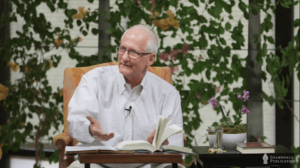
A Lecture Series on Asanga's Bodhisattvabhumi with Translator Artemus Engle
Art Engle has a Ph.D. in Buddhist studies from the University of Wisconsin; adjunct professor, interpreter, and translator; active in the development of a program for teaching Buddhist classics that integrates a study of the language and their application in practice. Tsadra Foundation Grantee in 2004; Fellow since 2005.
Deeply inspired by some thirty years of devoted study with his lama, Art Engle became a translator and, remaining inspired to this day, encourages others to learn original Dharma languages, as he did. Having realized, however, that few people are going to “buy into” his urgings in this regard, he forges ahead with translations. His wish is that practitioners will have access to written teachings that can augment direct oral teachings, the latter of which, avows Art, may be “evanescent” without written material to refer to.
His extensive projects include ten years of work on lamrim texts. Currently, he is immersed in two translation projects, one of them is translating Asanga’s Bodhisattva-bhumi, which outlines the entire bodhisattava path, and the other is a translation tentatively entitled “Quarrelsome Mister Egotism: A Buddhist Fable,” a lengthy scripture presenting the Prasangika view in poetic form, with wisdom and ignorance as characters having a conversation. So dedicated are Artemus’ labors, he confesses to seldom leaving his house. Indeed, he would like to see more translations of the extensive Maitreya-Asanga literature, and feels that it is better to focus on work that has yet to be translated into Western languages, rather than provide new translations of highly popular texts for which there are already multiple translations.

